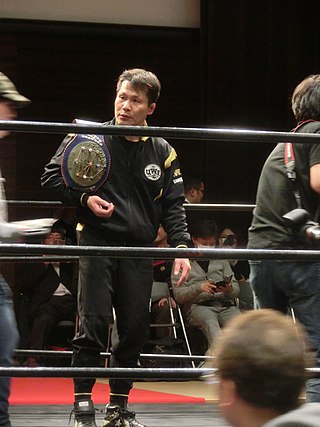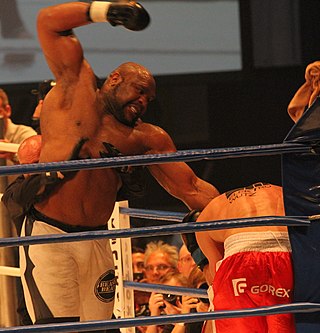
PRIDE Fighting Championships was a Japanese mixed martial arts promotion company. Its inaugural event was held at the Tokyo Dome on October 11, 1997. Pride held more than sixty mixed martial arts events, broadcast to about 40 countries worldwide. PRIDE was owned by the holding company Dream Stage Entertainment (DSE).

Pancrase is a Japanese mixed martial arts (MMA) promotion company based in Tokyo. It was founded in 1993 by professional wrestlers Masakatsu Funaki and Minoru Suzuki.
José Mário Sperry is a Brazilian heavyweight mixed martial artist. His specialty is Brazilian jiu-jitsu, grappling and ground fighting. He is also one of the founders of the Brazilian Top Team, where he trained fighters such as Antônio Rodrigo Nogueira, Antônio Rogério Nogueira, Ricardo Arona, and Paulo Filho, among others.

Mark Daniel Coleman is an American retired mixed martial artist, professional wrestler and amateur wrestler. Coleman was the UFC 10 and UFC 11 tournament champion, the first UFC Heavyweight Champion, and the Pride Fighting Championships 2000 Open Weight Grand Prix champion. At UFC 82 Coleman was inducted into the UFC Hall of Fame.

Igor Yaroslavovych Vovchanchyn is a retired Ukrainian mixed martial artist and kickboxer, who competed in early no holds barred MMA contests. After making his professional MMA debut in 1995, he won nine openweight mixed martial arts tournaments, 3 superfights, holds the second longest unbeaten streak in MMA and is the second most successful MMA fighter ever by number of wins achieved by way of knockout. Vovchanchyn has an MMA tournament named after him, the Igor Vovchanchyn Cup.
Sanae Kikuta is a Japanese mixed martial artist currently competing in the Welterweight division. A professional competitor since 1996, he has competed for the UFC, PRIDE Fighting Championships, Pancrase, DREAM, World Victory Road, DEEP, Shooto, and Vale Tudo Japan. He is the former Pancrase Light Heavyweight Champion (2001–2003) and the winner of the ADCC 88 kg class in 2001.

Kiyoshi Tamura is a Japanese retired professional wrestler and mixed martial artist. Once a student of legendary professional wrestlers Billy Robinson, Lou Thesz and Akira Maeda, Tamura was known for his skills in catch wrestling and is considered to be one of the greatest shoot wrestlers of all time. Competing exclusively in shoot style wrestling, Tamura began his career with UWF Newborn and later joined its successor group UWF International before transitioning to mixed martial arts.

Joshua Lawrence Barnett is an American mixed martial artist, submission wrestler, professional wrestler and color commentator currently signed to Bellator MMA. Barnett previously competed for the Ultimate Fighting Championship (UFC), where he was the youngest-ever UFC Heavyweight Champion. Barnett was the final Openweight King Of Pancrase, a finalist in both the 2006 PRIDE Openweight Grand Prix and the 2012 Strikeforce Heavyweight Championship Grand Prix. He has also competed in Affliction, World Victory Road, DREAM and Impact FC.
Ikuhisa Minowa is a Japanese mixed martial artist and professional wrestler currently competing in IGF as Minowaman. A professional MMA competitor since 1996, he was a longtime veteran of PRIDE and Pancrase and has also competed in other mixed martial arts promotions such as K-1 Hero's, Cage Rage, the SFL, Vale Tudo Japan, UFC, DREAM, and DEEP. He is the former DREAM Openweight Grand Prix Champion. Often undersized and a huge fan favorite in Japan, Minowa earned his nickname "The Giant Killer" by participating in many openweight contests, often submitting much larger opponents. Also renowned for his durability, he is a veteran of 115 fights, and is known for his trademark red speedo and mullet.
Tsuyoshi Kosaka is a retired Japanese mixed martial artist, submission grappler and professional wrestler who competed in the Heavyweight division. A professional MMA competitor from 1994 till 2022, he has competed for the UFC, PRIDE Fighting Championships, RIZIN, RINGS, Pancrase, and DEEP. Kosaka is the former King of Pancrase Super Heavyweight Champion.
Guy Mezger is an American martial artist, who competed in professional combat sports including full contact karate, kickboxing, and boxing, but is most recognized as a mixed martial arts (MMA) fighter. Mezger retired from professional competition on January 25, 2005. He is associated with Lion's Den and runs their school in Dallas. Mezger was a champion in mixed martial arts in two different promotions, the UFC and Pancrase. He holds wins over Tito Ortiz, Masakatsu Funaki, Yuki Kondo, Semmy Schilt, and Minoru Suzuki.

Sem "Semmy" Schilt is a Dutch actor and former kickboxer, Ashihara karateka and mixed martial artist. He stands 212 cm and weighs 116 kg. Schilt holds the distinction of being the only kickboxer to have won 5 major heavyweight tournaments, being a four-time K-1 World Grand Prix Champion and one time Glory Heavyweight Grand Slam Champion. He also held the K-1 Super Heavyweight Championship and the Glory Heavyweight Championship titles. He is the only fighter in K-1 history to win the world championship three times in a row, and also shares the record with Ernesto Hoost for most Grands Prix won, with four.
Emmanuel Yarbrough was an American martial artist, professional wrestler, football player and actor. He was particularly known for his career in amateur sumo, and held the Guinness World Record for the heaviest living athlete.
The heavyweight division in mixed martial arts (MMA) generally groups fighters between 206–265 lb (93.4–120.2 kg).

World Victory Road (WVR) was a Japanese mixed martial arts (MMA) organization which promoted the Sengoku Raiden Championship (SRC) in Japan. The organization was formed in 2007 following the purchase of PRIDE FC by Zuffa. It operated in conjunction with the Japan Mixed Martial Arts Federation (JMM). The Sengoku championship was broadcast on Fuji TV and pay-per-view in Japan, and on HDNet in United States.
Katsuhisa Fujii,(born August 15, 1972) is a Japanese retired mixed martial artist and professional wrestler, mostly known for his work in Pro Wrestling Zero1 and Hustle.
Shannon Grey Ritch is an American professional mixed martial artist, boxer, grappler, professional wrestler and kickboxer. In mixed martial arts competition he is the former King of the Cage Middleweight Champion and the inaugural BKFC International Heavyweight Champion in bare-knuckle boxing. A professional competitor since 1998, Ritch has competed for M-1 Global, Combate Americas, MFC, Shark Fights, Pancrase, Battlarts, K-1, Bare Knuckle Fighting Championship, PRIDE, Rebel Fighting Championship, New Japan Pro-Wrestling, King of the Cage, Gladiator Challenge, Hart Legacy Wrestling and the WEC.

In boxing, a weight class is a measurement weight range for boxers. The lower limit of a weight class is equal to the upper weight limit of the class below it. The top class, with no upper limit, is called heavyweight in professional boxing and super heavyweight in amateur boxing. A boxing match is usually scheduled for a fixed weight class, and each boxer's weight must not exceed the upper limit. Although professional boxers may fight above their weight class, an amateur boxer's weight must not fall below the lower limit. A nonstandard weight limit is called a catchweight.
The atomweight division in mixed martial arts generally refers to competitors weighing less than 48 kg (105.8 lb), depending on the promotion. It sits below the heavier strawweight division and is the lightest weight class widely recognized within MMA. The atomweight division in mixed martial arts is used almost exclusively for Women's MMA.

In kickboxing and mixed martial arts (MMA), "freak show fight" is an idiom for a bout featuring a deep disparity in skill, experience or weight between the fighters. This kind of matchup was common in the early period of mixed martial arts history, but it has become increasingly rare due to the regulation of athletic commissions and the implementation of official weight classes. However, freak show fights remain particularly associated in popular culture to Japanese promotions, where they are still occasionally hosted. Those bouts are usually a source of controversy among pundits, as they are perceived to elevate spectacle over true competition, but they retain a measure of acceptance among wide audiences due to their entertainment value.









